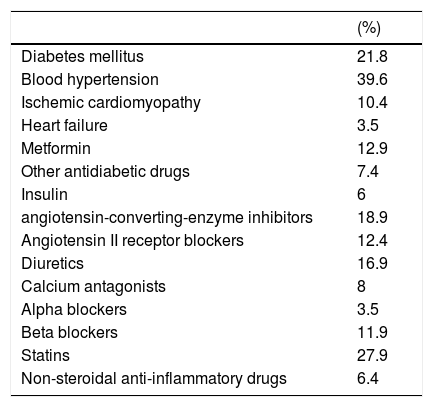To analyze the incidence of contrast-induced nephropathy in a cohort of patients undergoing computed tomography (CT) with intravenous iodinated contrast material. To evaluate the efficacy of N-acetylcysteine in preventing contrast-induced nephropathy.
Patients and methodsThis prospective observational study was carried out in the months comprising March 2016 through July 2016. We selected the first five patients scheduled to undergo CT examination each day who agreed to participate and signed the informed consent form. We recorded patients’ cardiovascular histories, chronic treatments, and indications for the CT examination. We measured blood levels of creatinine and urea before and after the CT examination. We used the Modification of Diet in Renal Disease (MDRD-4) equation to estimate the glomerular filtration rate. We analyzed the type and dose of contrast material. We recorded whether N-acetylcysteine was administered before the CT examination. We used SPSS 15.0® to compare means and proportions. Statistical significance was set at p<0.05.
ResultsNo incidents of contrast-induced nephropathy were detected in any of the 202 patients included [mean age, 63.92±12 years (range 22–87); 57.4% male; 21.8% diabetic; 39.6% hypertensive; 87.1% had MDRD4≥60ml/min/1.73m2 (89.45±14, range 62.36–134.14) and 12.9% had MDRD4<60ml/min/1.73m2 (45.38±11, range 9.16–58.90)]. The most common indication for CT examinations was oncologic (81.2%). The only contrast agent administered was iopamidol; the mean dose was 107.83±11ml (range 70–140). The mean interval between pre-CT and post-CT laboratory tests was 4.06±1 days. Only 13 patients received N-acetylcysteine; 9 of these had MDRD<60ml/min/1.73m2 and 4 had MDRD4≥60ml/min/1.73m2 (p=0.000).
ConclusionsThe incidence of contrast-induced nephropathy was not significant in patients with glomerular filtration rates greater than 30ml/min/1.73m2: these favorable results might be due to analyzing only scheduled examinations and to using relatively low doses of a “nonionic” iodinated contrast agent.
Analizar la incidencia de nefropatía por contraste en una cohorte de pacientes sometidos a tomografía computarizada (TC) con contraste yodado intravenoso. Valorar los resultados de la nefroprotección con N-acetilcisteína.
Pacientes y métodosEstudio observacional prospectivo, entre los meses de marzo y julio de 2016. Los pacientes seleccionados tenían programada una TC. Se incluyeron los primeros 5 pacientes de cada día, que aceptaban participar y firmaban el consentimiento informado. Se registraron antecedentes cardiovasculares, tratamientos crónicos e indicación de la TC. Se determinó la creatinina y la urea en sangre pre-TC y pos-TC. El filtrado glomerular se determinó por MDRD-4 (Modification of Diet in Renal Disease). Respecto al contraste, se analizó tipo y dosis. Se registró el uso de N-acetilcisteína anterior a la TC. Estadística: SPSS 15.0® utilizando comparación de medias y proporciones. Significación: p<0,05.
ResultadosNo se detectó ninguna NC en 202 pacientes estudiados. Datos globales: edad: 63,92±12 años (rango 22-87); 57,4% varones; 21,8% diabéticos; 39,6% hipertensos; 176 pacientes tenían MDRD4≥60ml/min/1,73m2 (89,45±14, rango 62,36-134,14) y 26 MDRD4<60ml/min/1,73m2 (45,38±11, rango 9,16-58,90). La principal indicación de TC fue oncológica (81,2%). El único contraste administrado fue iopamidol, en dosis de 107,83±11ml (rango 70-140). El intervalo de días entre analíticas fue de 4,06±1 días. Solo en 13 pacientes se administró N-acetilcisteína: en 9 con MDRD<60ml/min/1,73m2 y en 4 con MDRD4>60ml/min/1,73m2 (p=0,000).
ConclusionesLa incidencia de NC es no significativa en la cohorte estudiada con un filtrado glomerular superior a 30ml/min/1,73m2: la realización de TC de forma “programada”, utilizando un contraste yodado “no iónico” en dosis relativamente baja, es un factor que quizás explique estos resultados favorables.
Artículo
Comprando el artículo el PDF del mismo podrá ser descargado
Precio 19,34 €
Comprar ahora








